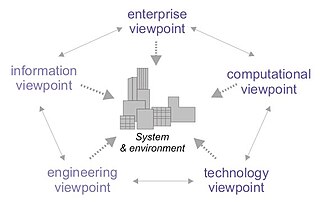Related Research Articles

Ada is a structured, statically typed, imperative, and object-oriented high-level programming language, extended from Pascal and other languages. It has built-in language support for design by contract (DbC), extremely strong typing, explicit concurrency, tasks, synchronous message passing, protected objects, and non-determinism. Ada improves code safety and maintainability by using the compiler to find errors in favor of runtime errors. Ada is an international technical standard, jointly defined by the International Organization for Standardization (ISO), and the International Electrotechnical Commission (IEC). As of 2020, the standard, called Ada 2012 informally, is ISO/IEC 8652:2012.

The ITU Telecommunication Standardization Sector (ITU-T) coordinates standards for telecommunications and Information Communication Technology such as X.509 for cybersecurity, Y.3172 and Y.3173 for machine learning, and H.264/MPEG-4 AVC for video compression, between its Member States, Private Sector Members, and Academia Members. ITU-T is one of the three Sectors of the International Telecommunication Union (ITU).

The Open Systems Interconnection model is a conceptual model that describes the universal standard of communication functions of a telecommunication system or computing system, without any regard to the system's underlying internal technology and specific protocol suites. Therefore, the objective is the interoperability of all diverse communication systems containing standard communication protocols, through the encapsulation and de-encapsulation of data, for all networked communication.

Pascal is an imperative and procedural programming language, designed by Niklaus Wirth as a small, efficient language intended to encourage good programming practices using structured programming and data structuring. It is named in honour of the French mathematician, philosopher and physicist Blaise Pascal.
In telecommunication, the term protocol-control information or PCI has the following meanings:
- The queries and replies among communications equipment to determine the respective capabilities of each end of the communications link.
- For layered systems, information exchanged between entities of a given layer, via the service provided by the next lower layer, to coordinate their joint operation.

X.25 is an ITU-T standard protocol suite for packet-switched data communication in wide area networks (WAN). It was originally defined by the International Telegraph and Telephone Consultative Committee in a series of drafts and finalized in a publication known as The Orange Book in 1976.
TTCN is a programming language used for testing of communication protocols and web services. A TTCN test suite consists of many test cases written in the TTCN programming language. Until version 2 the language was written in tables and called Tree and Tabular Combined Notation. Reading and editing this language required special TTCN editors. Beginning with version 3 TTCN was renamed to Testing and Test Control Notation. It is now closer to current programming languages and can be edited with traditional editors. TTCN-3 is more flexible than TTCN-2 in that it can be used for protocol testing as well as testing traditional software.
Modular programming is a software design technique that emphasizes separating the functionality of a program into independent, interchangeable modules, such that each contains everything necessary to execute only one aspect of the desired functionality.
ITU-T recommendation T.50 specifies the International Reference Alphabet (IRA), formerly International Alphabet No. 5 (IA5), a character encoding. ASCII is the U.S. variant of that character set.
Specification and Description Language (SDL) is a specification language targeted at the unambiguous specification and description of the behaviour of reactive and distributed systems.
This is an alphabetical list of articles pertaining specifically to software engineering.
T.51 / ISO/IEC 6937:2001, Information technology — Coded graphic character set for text communication — Latin alphabet, is a multibyte extension of ASCII, or rather of ISO/IEC 646-IRV. It was developed in common with ITU-T for telematic services under the name of T.51, and first became an ISO standard in 1983. Certain byte codes are used as lead bytes for letters with diacritics (accents). The value of the lead byte often indicates which diacritic that the letter has, and the follow byte then has the ASCII-value for the letter that the diacritic is on.
Programming languages are used for controlling the behavior of a machine. Like natural languages, programming languages follow the rules for syntax and semantics.
The Video Coding Experts Group or Visual Coding Experts Group is a working group of the ITU Telecommunication Standardization Sector (ITU-T) concerned with video coding standards. It is responsible for standardization of the "H.26x" line of video coding standards, the "T.8xx" line of image coding standards, and related technologies.

Reference Model of Open Distributed Processing (RM-ODP) is a reference model in computer science, which provides a co-ordinating framework for the standardization of open distributed processing (ODP). It supports distribution, interworking, platform and technology independence, and portability, together with an enterprise architecture framework for the specification of ODP systems.
Location awareness refers to devices that can passively or actively determine their location. Navigational instruments provide location coordinates for vessels and vehicles. Surveying equipment identifies location with respect to a well-known location wireless communications device.
A communication protocol is a system of rules that allows two or more entities of a communications system to transmit information via any kind of variation of a physical quantity. The protocol defines the rules, syntax, semantics and synchronization of communication and possible error recovery methods. Protocols may be implemented by hardware, software, or a combination of both.
The following outline is provided as an overview of and topical guide to C++:

Dansk Datamatik Center (DDC) was a Danish software research and development centre that existed from 1979 to 1989. Its main purpose was to demonstrate the value of using modern techniques, especially those involving formal methods, in software design and development.
References
- ↑ Jürgen F. H. Winkler; Georg Dießl (1992). "Object CHILL—an object oriented language for systems implementation". Proceedings of the 1992 ACM annual conference on Communications. Kansas City, Missouri, USA: Association for Computing Machinery. pp. 139–147. doi:10.1145/131214.131232. ISBN 0-89791-472-4 . Retrieved 2008-12-30.